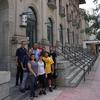When it comes to measuring the biggest percentage increases in home equity since 2012, metro Denver’s minority neighborhoods can’t be matched, according to a survey from real estate brokerage Redfin.
“Urban neighborhoods that are now in high demand typically had a minority ownership. That is why you are seeing those huge price gains,” said Michelle Thomas, a real estate broker with NXT Level Properties in Five Points.
But those big gains are an outcome of the big price declines and misery suffered during the housing crash and aren’t necessarily accruing fully to homeowners when they go to sell.
Predatory lending practices last decade disproportionately targeted minority borrowers, who were also more vulnerable to layoffs during the recession. That left minority communities with higher rates of foreclosure and steeper declines in home values and home equity, said Karla Kirkpatrick-Adams, a broker with Redfin in Denver.
Start with a small amount of equity and pile on big price gains like metro Denver has seen, and the percentage increases in home equity ramped up fast.
Scarcity is also at play. During the recovery, builders focused on higher-end properties and condo construction has remained anemic due to concerns over defects litigation. As first-time buyers and investors compete to find affordable properties, they have driven up home prices in the lowest-cost neighborhoods, Thomas said.

Redfin examined ZIP codes across metros nationwide and designated them as minority if more than half the households were black, non-white Hispanic or Asian. Mixed ZIP codes were those where minorities represented between 25 percent and just under half of households. White areas were defined as those where minorities represented under a quarter of households.
Redfin looked at the median sales price of a home and the average home equity for each ZIP code in 2012 and then in 2018. No area, regardless of racial composition, could match the percentage gains seen in Denver’s 15 ZIP codes made up predominately of minorities. These areas saw median home sale prices rise 158 percent and average equity gains increase more than 450 percent.
Nationally, minority ZIP codes were up 265 percent, according to Redfin.
In the 42 Denver area ZIP codes defined as white, median sales prices rose 85 percent and home equity rose 257 percent. Nationally, predominately white ZIP codes saw a 171-percent gain in equity.
In metro Denver’s 28 racially mixed ZIP codes, the median sales price rose 120 percent since 2012, while home equity rose 366 percent, compared to a 199-percent gain nationally.
There were three minority ZIP codes in Denver where average home equity rose more than five-fold in just six years.
In Federal Height’s 80260, the median sales price rose from $138,000 in 2012 to $312,000 this year. But the equity gains were much larger, going from $32,000 to $216,000, an increase of 575 percent.
The 80221 ZIP code saw the median sales price rise from $144,000 to $348,000, which represents a 165 percent gain in value in six years. The neighborhoods in southwestern Adams County saw home values rise after the Midtown community rose up on the old Sunstrand industrial site, Kirkpatrick-Adams said.
The 80010 ZIP code in north Aurora saw the largest jump in home prices at 209 percent, which set the stage for a 500 percent gain in average home equity. That area has seen heavy interest from fix-and-flip investors drawn by the Anschutz Medical Campus, Thomas said.
Real estate investors tend to be most active in older, often minority, neighborhoods, which they paper with mailers and knock on doors in an effort to secure a “quick cash closing,” Thomas said. Homeowners who aren’t tracking the market can let their homes go for less than they are worth, one reason she recommends homeowners get a second opinion from an agent.
Related Articles
-
Ex-Avalanche star Peter Forsberg’s former Golden home on market for $2.75M
-
Rent burdens in Colorado are heavier in many areas outside metro Denver
-
Zillow, Opendoor entering Denver home market with instant offers
-
Growing number of Denver metro residents looking for homes elsewhere, study says
-
Denver housing costs are high and traffic is worsening. Where are the best places to buy a commuter-friendly home?
Those investors also spend money fixing the properties they buy. A portion of what shows up as equity represents improvements to older homes, not necessarily what the original sellers are able to pocket, Thomas said.
Alfredo Salcedo, an agent at RE/MAX Leaders, said he is concerned that some of the neighborhoods with the biggest price increases in the recovery could be setting up for above average price declines in the next cycle.
For example, the median sales price in Sun Valley, ZIP code 80204, has now topped $400,000. The homes in that area are much older and smaller than what can be found at a similar price point in Aurora, Englewood or Littleton, he said.
“Honestly, when I get buyers and they want to live in those areas, the only one I recommend is Green Valley Ranch,” he said.



